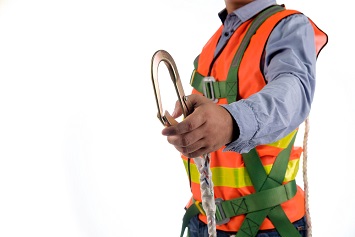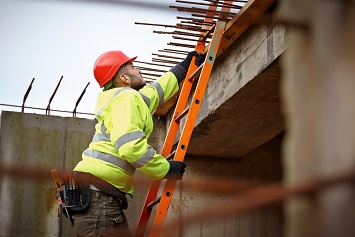Is OSHA more likely to inspect your worksite now that the agency assigns greater weight to inspections for its Focus Four hazards—falls, struck by, caught in, and electrocution?
Could you be facing jail time like a Maine roofing contractor indicted under the state’s workplace manslaughter law?
On September 10, OSHA unveiled its preliminary list of top 10 violations for fiscal year (FY) 2019 at the National Safety Council’s Congress & Expo. Four of the 10 most frequently cited standards—fall protection, scaffolds, ladders, and fall protection training—involve falls, one of the agency’s Focus Four hazards.
On September 27, OSHA released its revised enforcement weighting system, updating agency policy issued in 2015. The new OSHA Weighting System (OWS) went into effect October 1 for FY 2020. The OWS signals new enforcement priorities, including the Focus Four hazards, to area and field offices by changing the Enforcement Units (EUs) assigned to inspections.
All inspections rate at least 1 EU, but some inspections are given greater weight. Some inspections are heavily weighted, like those in criminal and significant cases, after catastrophes, or after worker fatalities; for Process Safety Management compliance; or under the agency’s chemical plant National Emphasis Program.
The agency decided to heavily weight inspections involving OSHA’s Focus Four hazards—falls, struck by, caught in/between, and electrocution—by awarding 3 EUs. The four hazards are the leading causes of workplace deaths, according to OSHA.
This summer, OSHA announced it was seeking $687,619 in penalties from two contractors at the Port of Wilmington after a worker suffered a fatal 40-foot (ft) fall from a scaffold.
The agency cited a Maine roofing contractor for a willful violation of the fall protection standard after a worker’s fatal fall. OSHA also cited the company with serious violations of the scaffolds, ladders, and fall protection training standards. OSHA hit the employer with $1.8 million in fines. The company’s owner was indicted by a Portland, Maine, grand jury under the state’s workplace manslaughter law, which carries a maximum 30-year prison sentence and $50,000 fine.
Fall Protection
OSHA’s fall protection standard, 29 CFR 1926.501, was cited 6,010 times between October 1, 2018, and August 31, 2019—more than any other job safety and health rule. The standard requires protecting employees working at 6 ft or more above a lower level. An employer must provide guardrails, safety nets, or personal fall arrest systems to prevent worker falls.
Any walking/working surfaces must have sufficient strength and structural integrity to support workers. A personal fall arrest system has three components: an anchor that other parts are rigged to, a full-body harness worn by a worker, and a lanyard or lifeline connecting the worker’s harness to the anchorage point.
Anchors may be temporary, but there are benefits to leaving them in place. Roofing is not always the last job on a construction project. A permanent anchor can be used by workers installing skylights or solar panels. It also can be used by roofers on later projects.
Some anchors may be used by more than one worker, so anchors must be able to hold at least 5,000 pounds per person, or else a qualified person must be able to determine that the anchor can support at least twice the impact load (a “safety factor” of 2).
Options for anchors include a peak anchor; a solid, nonmoving piece secured at the rooftop to trusses underneath; or a permanent D-ring attached to the truss frame.
Safety net systems can be installed underneath trusses to prevent workers from falling to a lower level. However, safety nets also must prevent contact with a surface or structure below.
An employer must control hazards that include:
- Areas where employees could fall into or onto dangerous equipment;
- Excavations such as pits, shafts, or wells that must be protected with barricades, covers, fences, or guardrail systems;
- Hoist areas where employees receive or move materials or other supplies;
- Holes, such as skylights;
- Overhand bricklaying work;
- Roofing work on both steep- and low-sloped roofs;
- Unprotected sides and edges of walking/working surfaces;
- Walking/working surfaces more than 6 ft above a lower level;
- Wall openings;
- Work involving precast concrete erection, including erecting beams, columns, floor and roof tees, and wall panels; and
- Working on formwork or reinforcing steel.
Employers also must protect employees from falling objects, ensuring every person on the worksite is wearing a hard hat. They also must take additional steps to ensure workers’ safety. Options include using guardrails, screens, or toeboards to prevent objects from falling to a lower level; putting a canopy in place to keep objects from going over the edge of a higher level; or creating a barricade around areas where objects might fall and prohibiting workers from entering the area.
Materials and tools also can create a tripping hazard. Materials should be carefully staged so workers can have quick and easy access to them without tripping over them. A slide guard can prevent objects from sliding off the roof.
Scaffolds
The scaffolds standard, 29 CFR 1926.451, was cited 2,813 times, making it the third most frequently cited standard. The standard applies to a wide variety of scaffolds, but requirements for aerial lifts, cranes, and derricks appear in other places in the construction standards. Hazards posed by all scaffolds include collapse, electric shocks, falls, and tipovers.
Working on scaffolds at heights of 10 ft or more require both a guardrail and personal fall arrest system. Body harnesses in personal fall arrest systems used on a scaffold must be secured by a lanyard to a horizontal or vertical lifeline or scaffold structural member.
Narrow-frame or Baker/Perry-style scaffolds, consisting of a frame and platform, top and midrails, and toeboard and locking wheels, are among the most popular types of scaffolds in the construction industry. Narrow-frame scaffolds are convenient for drywall installation, painting, and plastering because the scaffolds can be moved, and workers on platforms can frequently change position.
Employers must use a scaffold appropriate for the job and inspect the scaffold, site conditions, and work area before permitting workers to use a scaffold. Workers should be trained not to:
- Move a scaffold when workers on the scaffold are unaware of the move or are standing on any part extending beyond the wheels, casters, or other supports;
- Stand on any boxes, buckets, stepladders, or other items inside a scaffold to reach a greater height;
- Pull themselves from one location to another while standing in a scaffold; or
- Use a scaffold if it is broken, is incomplete, or has ill-fitting or missing pieces that should be replaced.
Ladders
The ladders standard, 29 CFR 1926.1053, was cited 2,345 times, making it the sixth most frequently cited standard. The ladders standard covers fixed ladders, portable ladders like A-frame stepladders and adjustable-height extension ladders, and job-made ladders. All ladders should be inspected by a competent person for defects. A competent person is one capable of identifying obvious and predictable hazards and authorized to correct them.
Job-made wooden ladders are ones built and installed at a construction site rather than commercially manufactured ones. Job-made ladders are temporary—used only until permanent stairways or fixed ladders can be installed. Ladders must be made with construction-grade lumber and include properly fastened and spaced side rails, cleats/steps, and filler blocks inserted between cleats. Workers using job-made ladders should not carry any objects or loads that would cause them to lose their balance and fall.
Commercial ladders are graded for the uses and loads they are capable of handling under nonmandatory American National Standards Institute consensus standards. Employers should use the ladder with the appropriate ladder duty rating for assigned tasks.
When climbing or descending any ladder, a worker should face the ladder and maintain a 3-point contact with the ladder—two feet and one hand or two hands and one foot. Workers should never carry tools or tool belts by hand.
Portable ladders such as extension ladders or stepladders should be placed on a stable, nonslippery surface. Stepladders should never be used folded as a single ladder or horizontally like a platform. Ladder spreaders should remain locked.
Extension ladders can be rigged into a ladder jack scaffold, but both the ladders and scaffolds standards apply to their rigging and use.
Fall Protection Training
The fall protection training requirement, 29 CFR 1926.503, was the eighth most frequently cited standard, cited 1,773 times. Every employee who might be exposed to fall hazards must be trained in fall protection. Fall protection training must cover:
- Nature of fall hazards on the job;
- Content of the fall protection standards;
- How to correctly erect, inspect, maintain, and disassemble guardrail, personal fall arrest, and safety net systems;
- How to correctly operate or use fall protection systems;
- Each employee’s responsibility for monitoring safety when fall protection systems are in use;
- Limitations of mechanical systems while performing roofing work on low-sloped roofs; and
- Proper handling and storage of equipment and materials, as well as how to erect overhead protection.
Employers must keep written records certifying worker fall protection training that include the employees’ names, date of training, and a trainer’s signature. Employees must be retrained whenever there are changes in the equipment or systems used.
Prepare for Hazards, Inspections
You can prevent deadly or disabling falls and save yourself from staggering OSHA penalties by planning fall protection measures for each job, purchasing and maintaining appropriate equipment, and ensuring all employees have current training.


